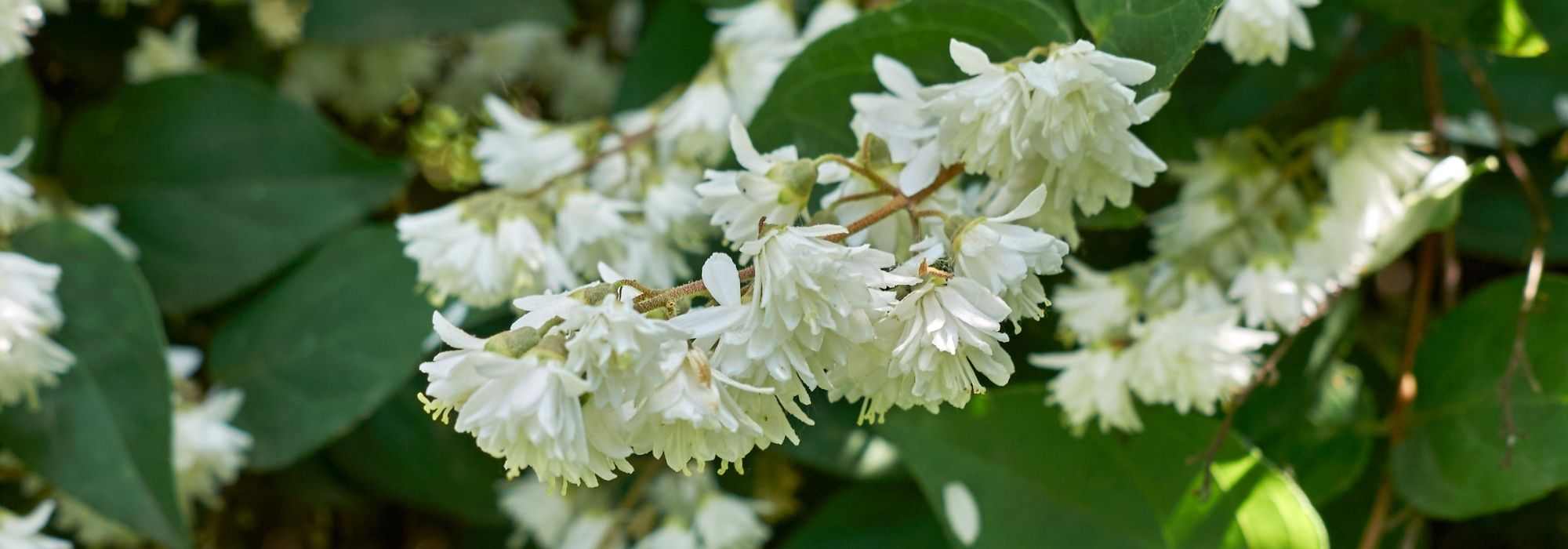
Choosing a Deutzia
The best varieties based on their use and aesthetics
Contents
Deutzia are highly valued ornamental bushes. Hardy, easy to grow, disease-resistant, and extremely floriferous, they lend themselves to multiple uses, whether in a flowerbed, as part of a flowering hedge, as groundcover, or even in pots. Their shades of pure white, pink, or bicolour, along with the shape of their flowers, bring a romantic charm to any garden or terrace. Blooming as early as April for the earliest varieties, some can even be noticed in autumn, and once winter arrives, they stand out with their beautifully exfoliating cinnamon bark. Fast-growing, they are therefore essential bushes perfectly suited for both beginner and experienced gardeners, who will find in this article all the criteria to consider when choosing their Deutzia, along with tips on how to use it in the garden or in pots.
According to their use
Large Deutzia for hedges
Large Deutzia can certainly find a place at the back of borders, but their use is also ideal in a flowering hedge, alongside other shrubs that bloom a little before (Forsythia, wild Camellias, Japanese Quince…) or after them (Abelia, Buddleia, Ceanothus, Hydrangea…). Among the varieties with white, double flowers, well-suited for creating fairly tall hedges (2 to 3 metres), Deutzia crenata ‘Pride of Rochester’ and Deutzia ‘Magnifica’ easily fulfil their role thanks to their rapid growth. If you are looking for more pinkish tones, opt for Deutzia scabra such as ‘Plena’ or ‘Codsall Pink’, or for a hybrid like ‘Mont Rose’, all three very graceful.
→ Discover our selection of 6 Deutzias perfect for a flowering hedge.
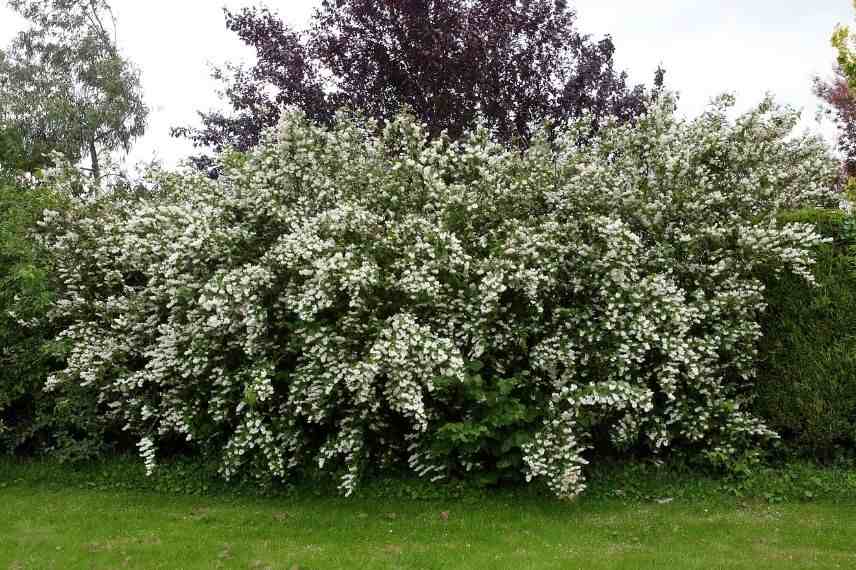
Deutzia ‘Pride of Rochester’
Deutzia Spreading, ideal as groundcover
Some Deutzia adopt a more compact, even slightly spreading habit, making them excellent groundcovers, which can, for example, enhance a rockery or be used as edging. This is the case for recent hybrids like Deutzia ‘Yuki Snowflake’ (white flowering) and ‘Yuki Cherry Blossom’ (pink flowering), which form cushions about fifty centimetres in all directions. Their low branches can even root themselves upon contact with the soil.
Deutzia gracilis ‘Nikko’ is also suitable for this use, and it offers beautiful autumn hues. A bit more imposing and spectacular, Deutzia rosea ‘Campanulata’, with its 1.20 m in all directions, requires more space to express itself. It can beautifully adorn a dull bank.
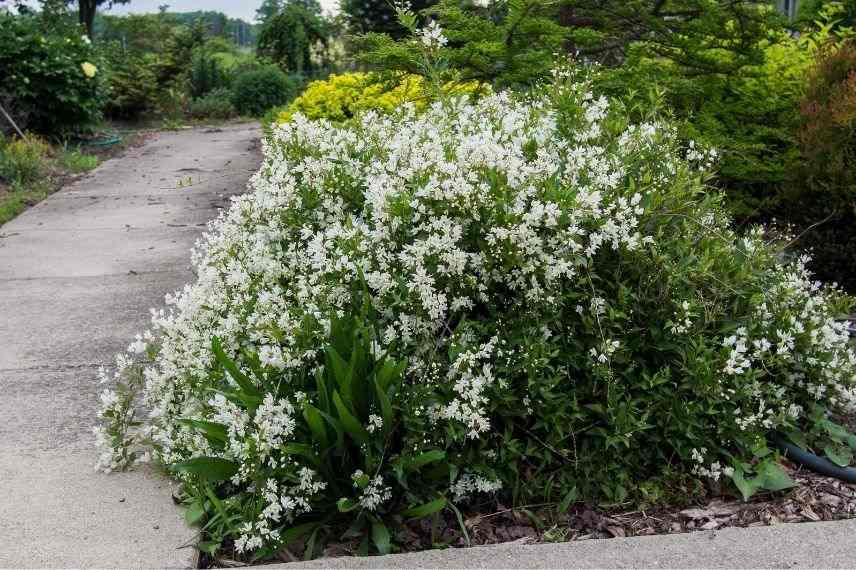
Deutzia gracilis ‘Nikko’ (photo F.D. Richards – Flickr)
Small Deutzia for Pots
If you only have a terrace, balcony, or patio, you can also enjoy the beautiful flowering and romantic look of a Deutzia, thanks to compact varieties, which take up little space and thrive perfectly in pots. Due to their size, the varieties ‘Yuki Snowflake’ and ‘Yuki Cherry Blossom’, mentioned above, are particularly well-suited for this use. Deutzia gracilis, which does not exceed 1 m in all directions, takes on the appearance of an avalanche of white flowers around June. If space is limited, its variant ‘Nikko’ is half the size. With its flowering lasting until autumn, Deutzia setchuenensis ‘Corymbosa’ is the only one to rebloom, even if its corollas become more discreet in late season.
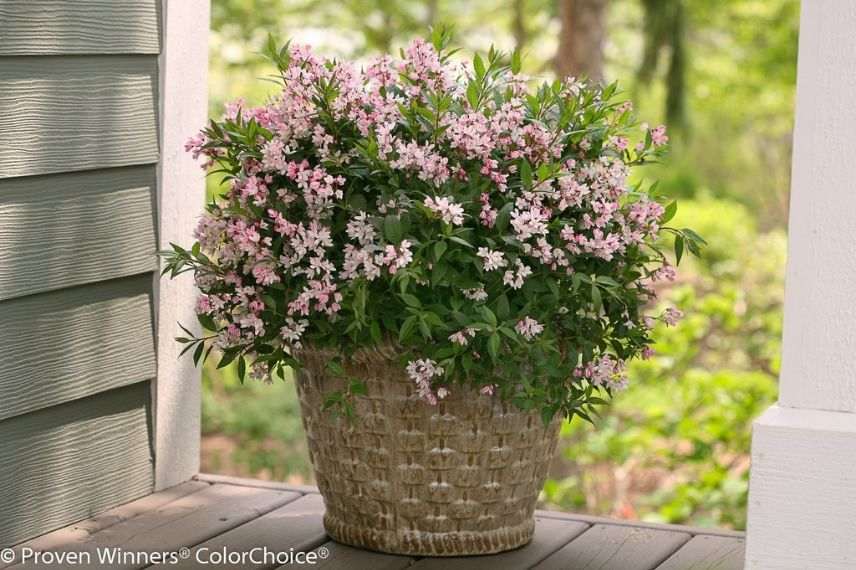 Deutzia ‘Yuki Cherry Blossom’[/caption>
Deutzia ‘Yuki Cherry Blossom’[/caption>
Read also
Deutzia: planting, pruning, careAccording to the colour of the flowers
It must be acknowledged that the range of colours offered by Deutzia is not very varied, but this is a minor flaw when one sees a specimen laden with a multitude of flowers, with bumblebees bustling around the bush. The two available colours are white and pink, the latter offering interesting shades, often in bi-coloured versions.
Deutzias with pure white flowers
White is a colour that pairs well with all others, and it helps to attenuate stronger hues. Deutzia ‘Pride of Rochester’ and ‘Magnifica’ are among the largest in this colour. In full bloom, they appear covered in late snow that brightens the garden. Also in immaculate white, Deutzia gracilis (and its cultivar ‘Nikko’), Deutzia ‘Yuki Snowflake’ and ‘Campanulata’ integrate more easily into a garden where space is more limited. With Deutzia ‘Corymbiflora’, the white shades complement autumn foliage and flowering, while Deutzia pulchra offers a beautiful cinnamon bark that remains very attractive, even once the bush is bare in winter.

Deutzia ‘Pride of Rochester’
Deutzias with pink and bi-coloured flowers
Few Deutzia have uniformly pink corollas, but this is the case with Deutzia ‘Lavender Time’, a variety with cup-shaped flowers that evolve from pale pink to lavender as they reach ripeness. From a washed pink to a lilac mauve, Deutzia elegantissima ‘Rosealind’ is a highly floriferous shrub of modest size (1.5m), essential in a flowering garden. In many specimens, pink and white blend to create a display that is both graceful and hypnotic. To enjoy this, plant varieties such as ‘Mont Rose’, ‘Codsall Pink’ or ‘Plena’, three specimens with slightly paler shades. ‘Raspberry Sundae’ and ‘Strawberry Fields’ are a bit more vibrant and intense pink. In pots, a variety like Deutzia ‘Yuki Cherry Blossom’ brings a fresh pink note that is welcome on a terrace.
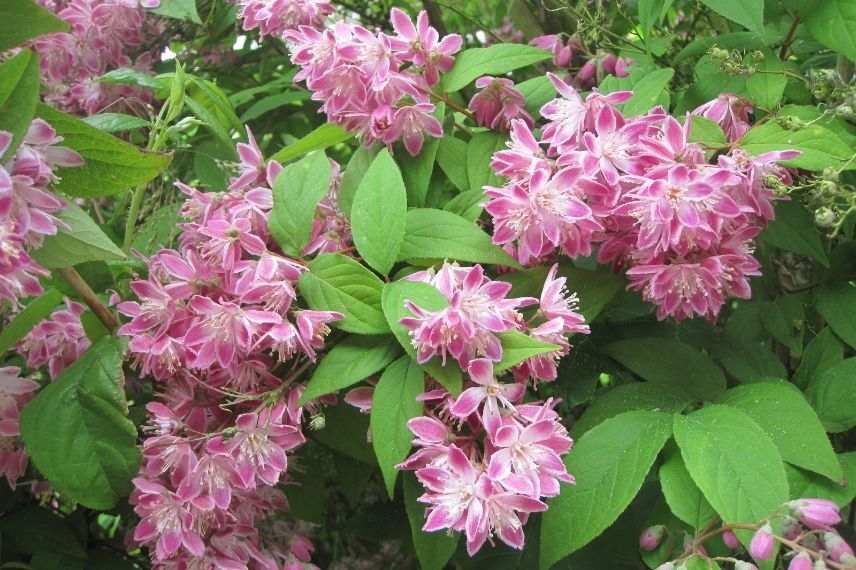
Deutzia ‘Strawberry Fields’
Discover other Deutzia
View all →Available in 1 sizes
Available in 1 sizes
Available in 0 sizes
Available in 2 sizes
Available in 2 sizes
Available in 3 sizes
Available in 2 sizes
Available in 3 sizes
Available in 1 sizes
Available in 2 sizes
According to the shape of the flowers
The shape of flowers can vary from one species to another. While these differences may not be very pronounced, they can be leveraged for associations with other plants.
Star-shaped simple flowers
This is the most common type of flower found in Deutzia. Among the varieties with simple flowers, the famous Deutzia ‘Perle Rose’, ‘Strawberry Fields’ (syn. ‘Tourbillon Rouge’), ‘Mont Rose’, or Deutzia gracilis are noteworthy. The Deutzia repeat flowering ‘Corymbiflora’, along with hybrids like ‘Yuki Cherry Blossom’ and ‘Snowflake’, produce simple flowers that are more or less star-shaped.
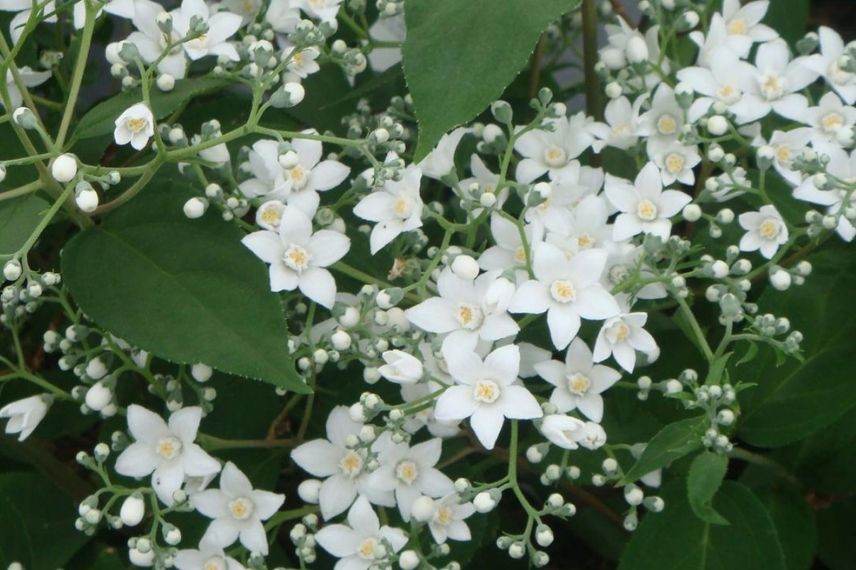
Deutzia ‘Corymbiflora’ (photo Denolf Plantes)
Double flowers
Some species and cultivars reward us with double flowering, which adds a different charm at the time of blooming. ‘Pride of Rochester’ is well known for this, as is Deutzia magnifica or Deutzia scabra ‘Plena’. Also worth trying in this category of double flowers are Deutzia ‘Codsall Pink’ with its beautiful pale pinkish-white flowers.
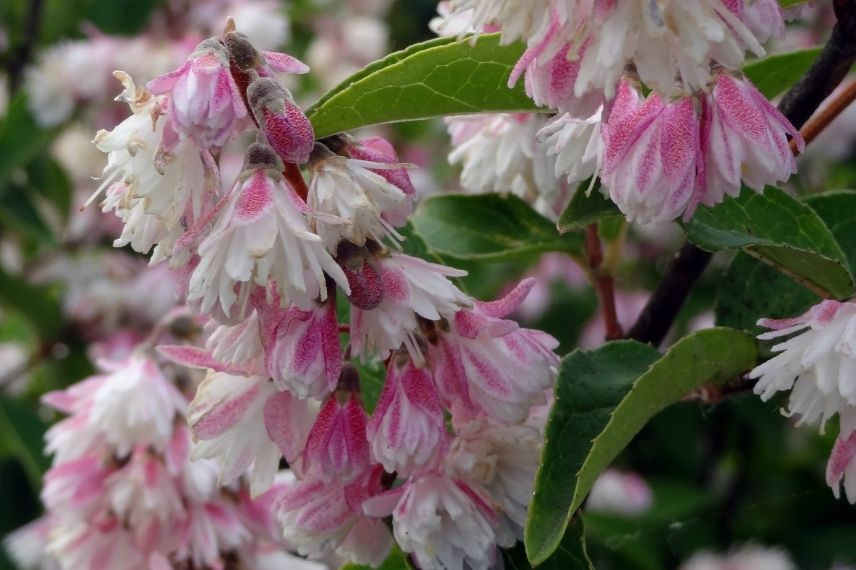
Deutzia scabra ‘Plena’
The “originals”
Some Deutzia showcase originality, with corollas that attempt to mimic the flowering of other shrubs. For instance, Deutzia purpurascens ‘Kalmiiflora’ presents flowers reminiscent of those produced by Kalmia. Meanwhile, Deutzia rosea ‘Campanulata’ opts to display campanulate flowers, in white bell-shaped blooms slightly tinged with pink, while Deutzia compacta ‘Lavender Time’ has bell-shaped flowers that bear little resemblance to those typically seen in this genus.

Deutzia purpurascens ‘Kalmiiflora’ and Deutzia compacta ‘Lavender Time’ (photo wallygrom)
Read also
Deutzia: 5 lovely pairing ideasAccording to their flowering period
If you think that all Deutzia bloom at the same time, think again! Of course, the vast majority brighten up May and June, but some choose to make an early appearance, while others seem to prefer to take their time, even extending their display late into the season. Keep in mind that depending on your climate and weather conditions, which can vary from year to year, flowering may be advanced or delayed by up to a fortnight.
The earliest Deutzias
Among those that can be seen in bloom earliest in the season (sometimes as early as April), we can mention Deutzia ‘Raspberry Sundae’, a compact variety (1.20m) with bicoloured white and lilac flowers, which enhances both a flowerbed and a terrace as it can be grown in a pot. Also early bloomers are ‘Yuki Snowflake’, ‘Yuki Cherry Blossom’ and Deutzia magnifica which flourish between April-May and June-July.
A repeat Flowering Deutzia with autumn bloom
While all Deutzia have finished blooming, one species stands out for its resilience and continues to produce corollas, sometimes until October, if the weather conditions are favourable and the soil remains moist. Deutzia setchuenensis ‘Corymbiflora’ indeed starts its flowering with the bulk of the group, and after taking a break during the hottest part of summer, it develops new white corollas thanks to a wetter late season.
For their decorative bark
Young shoots of Deutzia often display reddish hues, allowing them to be distinguished from older ones, which turn green and then, as they grow and thicken, take on a cinnamon brown tint. Their bark then peels off in strips, giving the bush additional ornamental value. The naked bush remains decorative even in the heart of winter, especially if you position it so that this peeling is backlit by the low morning or evening sun. Among all species, Deutzia pulchra is undoubtedly the one with the most striking and beautiful bark.
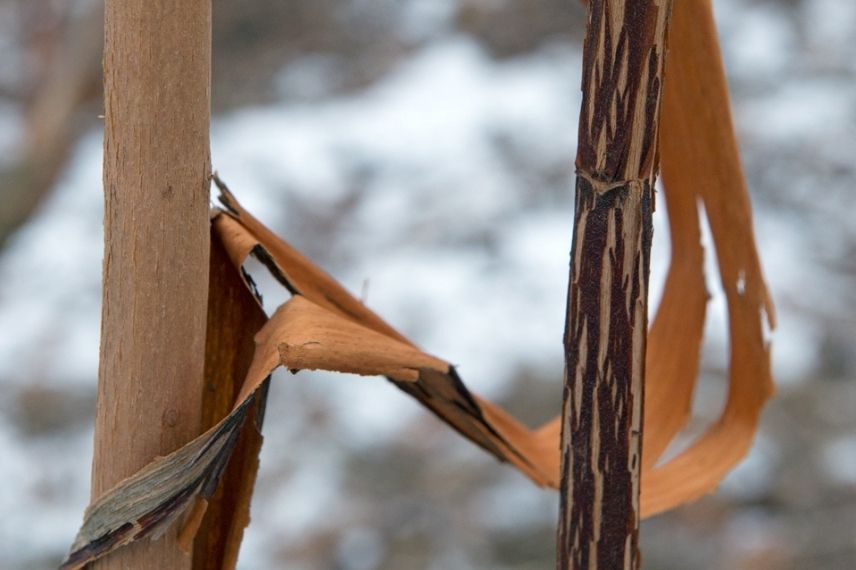
Old bark of Deutzia peeling off in strips (photo Plant Image Library – Flickr)
For their growth rate
Deutzia are generally fast-growing bushes, which can be enjoyed without having to wait for years. However, some take a little longer to settle in. This is particularly true for species with a groundcover habit, such as Deutzia ‘Yuki Snowflake’, ‘Yuki Cherry Blossom’, Deutzia ‘Nikko’ or Deutzia rosea ‘Campanulata’.
- Subscribe!
- Contents
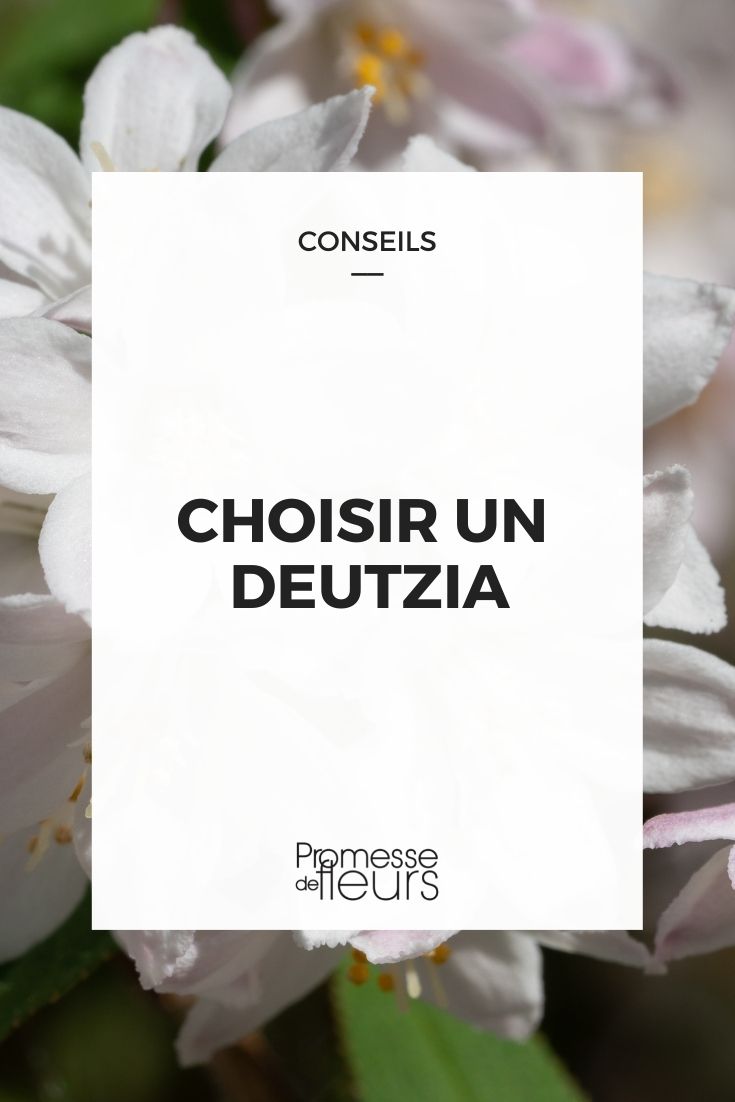

































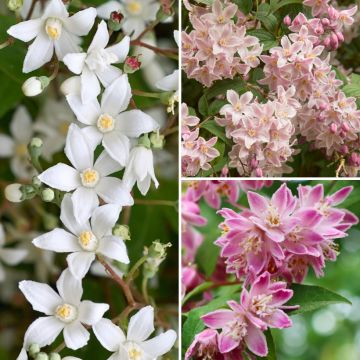
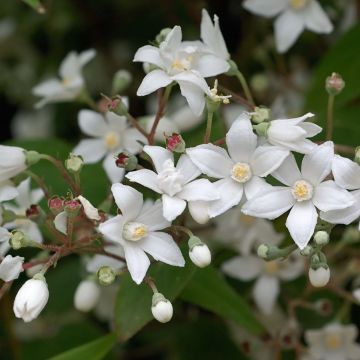
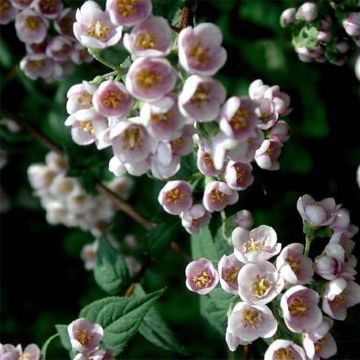

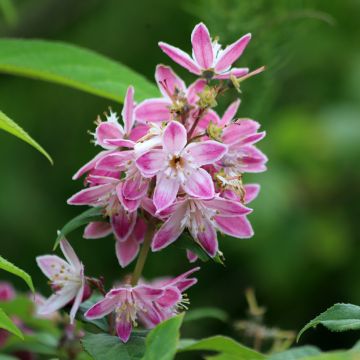


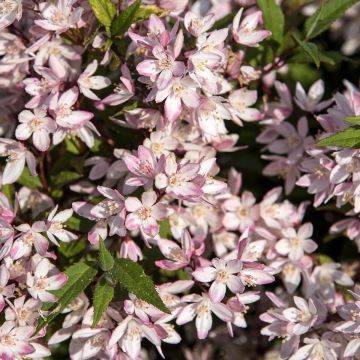
Comments